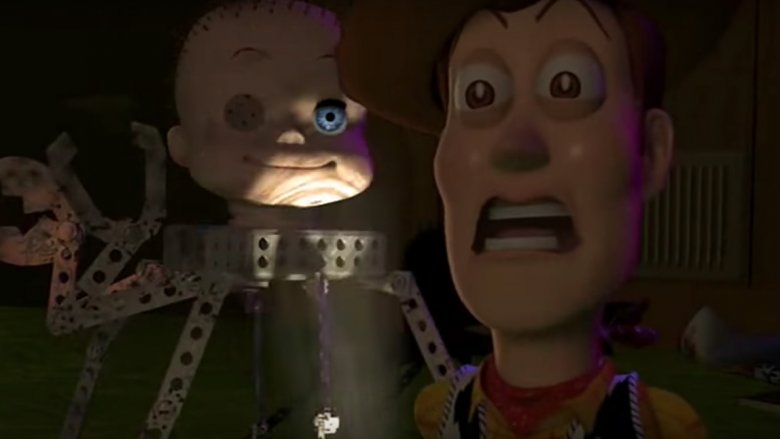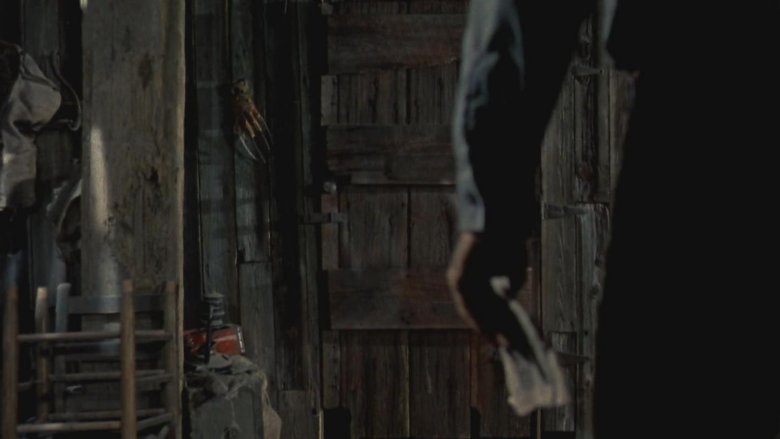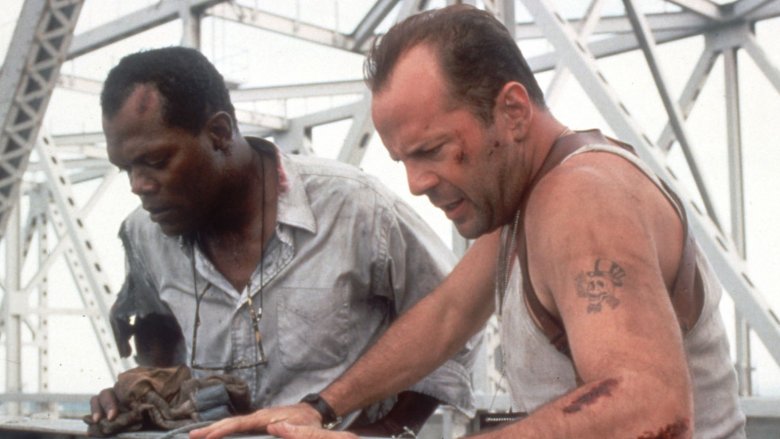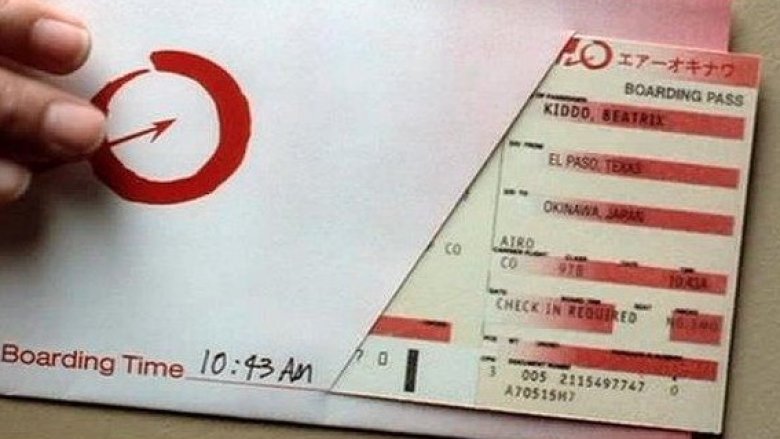The Most Elaborate Easter Eggs Ever Placed In Film
Filmmaking is hard work requiring thousands of hours spent on details that viewers will never notice, all with the intent of crafting a fictional world that feels seamless. It makes sense, then, that some directors, set designers, writers, and even actors will nestle sly jokes or references into the finished product. It's an easy way to have fun on set, a private joke between the makers of the film and the viewer savvy enough to pick up on it. From subtle winks to other properties to jaw-dropping set design, here are the most elaborate Easter eggs ever placed in film.
Harry Potter and the Prisoner of Azkaban
The Harry Potter franchise is arguably one of the most popular in the history of fiction, with best-selling books, beloved movies, and even a popular theme park. Part of the appeal is that the stories really are for all ages, marrying a wholesome child's outlook with genuinely adult themes, all while steering clear of the explicit violence and sex that many parents would frown upon. Sure, the books were once attacked for encouraging witchcraft, but that furor has long since subsided.
And yet it isn't all quite so innocent. In the credits for Harry Potter and the Prisoner of Azkaban, the movie's imagery matches that of the Marauder's Map, a magical map that shows the location of everyone on the Hogwarts grounds. It's a fun way to pay homage to one of the magical items used in the stories, but there's a dirty secret hiding in there: in the credits, in the bottom left corner of the school, viewers can see two pairs of feet crossed and shaking.
It didn't take fans long to infer that the two pairs of shoes were a couple of students (or teachers) who snuck into a corner closet to fool around. In an interview with Rus Wetherell, the credits designer, he said the couple were just kissing on the cheek, but considering the movie has a PG rating, he might be playing it safe on the record. He also added that there remain dozens of Easter eggs in the credits that no one's found yet, so who knows what else he snuck in there.
The Departed
Martin Scorsese has been making incredible movies for decades, often with incredibly charismatic actors playing mobsters, and 2006's The Departed is no different. Starring a ridiculously loaded cast that included Jack Nicholson, Leonardo DiCaprio, and Martin Sheen, and based on the phenomenal Hong Kong noir Infernal Affairs, The Departed was everything fans had come to expect from the godfather of Mafia cinema.
Scorsese even paid homage to the actual movie The Godfather by foreshadowing every single character's death with an "X" in the shot behind them—a tribute to The Godfather's use of oranges to signify death. While the movie's twists and turns seem completely confusing, you can track where each character is going to end up by whether they have an X behind them.
In fact, while a significant chunk of the cast gets killed off after the X motif appears, Dignam (Mark Wahlberg), usually has a straight line behind his head. It's a sly acknowledgement of his status as a straight shooter (and considering the end of the movie, quite literally a person who shoots straight) while everyone else is double-crossing each other.
Toy Story
It's almost impossible to overstate the importance of Toy Story to Disney, and film history in general. The massively successful computer-animated film changed the style for modern all-ages films, put Pixar on the map, and did it all while being a genuinely great all-ages story that was only half constant references to horror classic The Shining.
What does Toy Story, a family-friendly film about living toys, have to do with Stanley Kubrick's terrifying masterpiece? Well, for starters, Sid's house, where Buzz and Woody end up in the climax of the film, is almost ceiling-to-floor references to The Shining. The carpet pattern in Sid's house is literally identical to that of the haunted hotel. Once you add in the slow break from reality that Buzz experiences, the horrifying toy creatures in Sid's room, and the fact that both movies involve a child horrified by glimpsing a hidden world of immortal beings that might wish him harm, and well ... we're lucky Toy Story didn't have a drawn-out scene of Woody typing out hundreds of pages of "All work and no play (with me) makes Andy a DEAD boy."
It seems too bizarre to be true, but The Shining and the Toy Story franchise are inextricably linked at this point, with a whole cavalcade of references and winks placed in Toy Story 3 by director (and Kubrick super-fan) Lee Unkrich.
Wes Craven and Sam Raimi
You can't really talk about the history of horror movies over the last few decades without touching on Sam Raimi and Wes Craven. The two directors have had an incalculable influence on the current state of horror and horror comedies, and they both worked their way up with guerrilla filmmaking techniques and cult classic movies. But while the two share similar career paths, there's one specific commonality that's less well-known: their habit of one-upping each other with references to the other's films.
In 1977, Raimi thought he saw a Jaws poster in Craven's The Hills Have Eyes, and thought it would be fun to do to Craven what Craven had done to Spielberg. Raimi put a torn-apart poster of The Hills Have Eyes on a wall in his low-budget classic Evil Dead as a friendly nod to Craven's horror work. In 1984's A Nightmare On Elm Street, Craven had a character watch Evil Dead and continually nod off to sleep.
Raimi upped the ante by placing Freddy's iconic glove in a couple of scenes in Evil Dead 2, possibly even using the actual prop itself. The friendly rivalry even continued into the '90s with Craven's Scream showing a group of teenagers eventually choosing not to watch Evil Dead. That spelled the end of their onscreen back-and-forth until Craven's death, when Raimi paid homage in season 2 of Ash Vs. Evil Dead by once again including a The Hills Have Eyes poster.
Die Hard with a Vengeance
Die Hard with a Vengeance has its own twisting tale of Hollywood woe, with a script that was repurposed from a couple of different famous action movie sequels, but that's not why we're here today. Instead, let's talk about how Pulp Fiction might as well be Die Hard 2.5.
In Die Hard with a Vengeance, John McClane is asked what he's been doing since the events of Die Hard 2. Despite viewers assuming that he's the busiest cop on the planet (which would be a fair guess, since he foils more fake terrorist plots than James Bond), he responds that he's been "smoking cigarettes and watching Captain Kangaroo." It seems like a fairly in-character quip for McClane, quoting the famous lyrics of "Flowers on the Wall," although we wouldn't have pegged him as a Statler Brothers fan.
But there's a deeper reference in there, which is that the song is used in Quentin Tarantino's Pulp Fiction, specifically with scenes involving Butch, who was played by ... Bruce Willis. What's more, Pulp Fiction came out between Die Hard 2 and Die Hard with a Vengeance, which means the quip works as a fairly accurate summation of what Bruce Willis himself was doing in between movies. Plus, Pulp Fiction also starred the inimitable Samuel Jackson, who makes his debut in Die Hard with a Vengeance as an unwilling partner to McClane's signature brand of havoc.
Zootopia
At first glance, Frozen and Zootopia seem like they have nothing in common. Sure they're both about a woman's attempt to carve out self-sufficiency in a world that expects her to fit a role, and is openly frightened by her unwillingness to fall in line, but one movie has talking animals while the other has a talking snowman, so they're pretty different.
There is one very specific, hidden reference to Frozen in Zootopia, though. Midway through Zootopia, Judy and Nick interrogate Duke Weaselton, who clarifies that his name is pronounced "weasel town." The character is voiced by Alan Tudyk, who also played the Duke of Wesealton in Frozen, who constantly had to correct other characters' mispronunciation of his name as "weasel town." While there are various other references in Zootopia to Frozen, this takes the cake for most elaborate, since it involves hiring the same voice actor to play a character whose primary purpose is as a wink to a previous Disney film. Plus, Duke Weaselton almost gets iced just like the Duke of Weaselton nearly got iced in Frozen.
Back to the Future
Back to the Future is a timeless classic about a rebellious teenager, his creepy old man best friend, and his uncomfortable almost affair with his mother. Ah, but we kid. The movie's a classic for a reason, not the least of which is an excellent script that keeps the rules of time travel clean and simple while foregrounding Marty's relationship to his older, more knowledgeable friend. The focus on time travel along with the dynamic of Marty and Doc might seem a little familiar to anyone who grew up watching the Bullwinkle segments of Peabody's Improbable History, a cartoon about a young boy traveling through time with his learned dog (who could talk).
It's safe to say that the makers of Back to the Future were likewise aware of their predecessors since the movie has Marty crash into a barn owned by the Peabody family. They even have a young son, Sherman (identified in the credits), who thinks Marty is an alien. There's no dog in the house, though, so it's safe to say that it's just a winking nod to the original time-traveling duo, and not an official crossover.
KIll Bill
Kill Bill features a number of the meta-textual flourishes that director Quentin Tarantino's become known for, from the blink-and-you'll-miss-it nod to the Deadly Viper Assassination Squad being the show that Uma Thurman's Mia auditioned for in Pulp Fiction to the constant references to classic Asian martial arts movies. Kill Bill Vol. 1 puts the emphasis on the action, with characters talking around Uma Thurman's character, even going so far as to list her only as "The Bride" in the credits. Bill is even bleeped out when he says her name early on.
But the Bride's real name was never a secret, even while fans were waiting for the release of Vol. 2 to answer their lingering questions. When she buys a ticket to Okinawa in a quick-cut montage in the first half of the movie, viewers can clearly see that the name on the ticket is Beatrix Kiddo—her real name. It's a fast-edited scene, so viewers could be forgiven for missing it, but the use of her real name on a plane ticket also foreshadows how hands-off Bill is about her mission for revenge, hinting at the controversial ending of Vol. 2 years before it was released.
Fight Club
David Fincher has earned a reputation as a meticulous director over the years, with stories of actors having to suffer through hundreds of takes to find the exact one he wants. But even for Fincher, his keen attention to detail on Fight Club takes the cake—or the coffee: he made sure there was a Starbucks cup in every single scene. There are tons of subtle hints that point to the movie's big twist, but this might be the only Easter egg that took a ridiculous amount of planning to offer an uncanny commentary on the proliferation of brand awareness and ownership hidden in a movie that's explicitly denouncing corporate ownership of human lives.
Fincher has also claimed that he placed a can of haggis in every single shot of The Game, but he just did that as a prank on cinematographer Harris Savides, whose nickname is Haggis. Maybe Fincher's less of a genius filmmaker and more of a prankster who occasionally makes movies.



